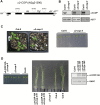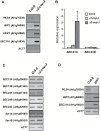α2-COP is involved in early secretory traffic in Arabidopsis and is required for plant growth
- PMID: 28025315
- PMCID: PMC5441910
- DOI: 10.1093/jxb/erw446
α2-COP is involved in early secretory traffic in Arabidopsis and is required for plant growth
Abstract
COP (coat protein) I-coated vesicles mediate intra-Golgi transport and retrograde transport from the Golgi to the endoplasmic reticulum. These vesicles form through the action of the small GTPase ADP-ribosylation factor 1 (ARF1) and the COPI heptameric protein complex (coatomer), which consists of seven subunits (α-, β-, β'-, γ-, δ-, ε- and ζ-COP). In contrast to mammals and yeast, several isoforms for coatomer subunits, with the exception of γ and δ, have been identified in Arabidopsis. To understand the role of COPI proteins in plant biology, we have identified and characterized a loss-of-function mutant of α2-COP, an Arabidopsis α-COP isoform. The α2-cop mutant displayed defects in plant growth, including small rosettes, stems and roots and mislocalization of p24δ5, a protein of the p24 family containing a C-terminal dilysine motif involved in COPI binding. The α2-cop mutant also exhibited abnormal morphology of the Golgi apparatus. Global expression analysis of the α2-cop mutant revealed altered expression of plant cell wall-associated genes. In addition, a strong upregulation of SEC31A, which encodes a subunit of the COPII coat, was observed in the α2-cop mutant; this also occurs in a mutant of a gene upstream of COPI assembly, GNL1, which encodes an ARF-guanine nucleotide exchange factor (GEF). These findings suggest that loss of α2-COP affects the expression of secretory pathway genes.
Keywords: Arabidopsis; COPI; COPII; Golgi apparatus; coat protein; p24 family protein; α1-COP; α2-COP; SEC31.
© The Author 2016. Published by Oxford University Press on behalf of the Society for Experimental Biology.
Figures







Similar articles
-
The presence of β'1-COP and β'2-COP is required for female and male gametophyte development.Plant Reprod. 2023 Dec;36(4):343-347. doi: 10.1007/s00497-023-00467-6. Epub 2023 Jun 2. Plant Reprod. 2023. PMID: 37266760 Free PMC article.
-
Differential Involvement of Arabidopsis β'-COP Isoforms in Plant Development.Cells. 2022 Mar 9;11(6):938. doi: 10.3390/cells11060938. Cells. 2022. PMID: 35326389 Free PMC article.
-
Loss of Arabidopsis β-COP Function Affects Golgi Structure, Plant Growth and Tolerance to Salt Stress.Front Plant Sci. 2020 Apr 15;11:430. doi: 10.3389/fpls.2020.00430. eCollection 2020. Front Plant Sci. 2020. PMID: 32351533 Free PMC article.
-
The role of ADP-ribosylation factor and SAR1 in vesicular trafficking in plants.Biochim Biophys Acta. 2004 Jul 1;1664(1):9-30. doi: 10.1016/j.bbamem.2004.04.005. Biochim Biophys Acta. 2004. PMID: 15238254 Review.
-
COPs regulating membrane traffic.Annu Rev Cell Dev Biol. 1995;11:677-706. doi: 10.1146/annurev.cb.11.110195.003333. Annu Rev Cell Dev Biol. 1995. PMID: 8689572 Review.
Cited by
-
Arabidopsis TETRASPANIN8 mediates exosome secretion and glycosyl inositol phosphoceramide sorting and trafficking.Plant Cell. 2024 Feb 26;36(3):626-641. doi: 10.1093/plcell/koad285. Plant Cell. 2024. PMID: 37950906 Free PMC article.
-
The presence of β'1-COP and β'2-COP is required for female and male gametophyte development.Plant Reprod. 2023 Dec;36(4):343-347. doi: 10.1007/s00497-023-00467-6. Epub 2023 Jun 2. Plant Reprod. 2023. PMID: 37266760 Free PMC article.
-
An Overview of Protein Secretion in Plant Cells.Methods Mol Biol. 2024;2841:19-36. doi: 10.1007/978-1-0716-4059-3_2. Methods Mol Biol. 2024. PMID: 39115762 Review.
-
Critical Determinants in ER-Golgi Trafficking of Enzymes Involved in Glycosylation.Plants (Basel). 2022 Feb 4;11(3):428. doi: 10.3390/plants11030428. Plants (Basel). 2022. PMID: 35161411 Free PMC article. Review.
-
Motif-based endomembrane trafficking.Plant Physiol. 2021 May 27;186(1):221-238. doi: 10.1093/plphys/kiab077. Plant Physiol. 2021. PMID: 33605419 Free PMC article.
References
-
- Abramoff MD, Magelhaes PJ, Ram SJ. 2004. Image processing with ImageJ. Biophotonics International 11, 36–42.
-
- Boevink P, Oparka K, Santa Cruz S, Martin B, Betteridge A, Hawes C. 1998. Stacks on tracks: the plant Golgi apparatus traffics on an actin/ER network. The Plant Journal: for Cell and Molecular Biology 15, 441–447. - PubMed
MeSH terms
Substances
LinkOut - more resources
Full Text Sources
Other Literature Sources
Molecular Biology Databases

